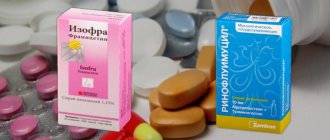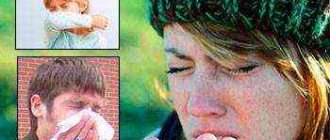Types of nasal discharge
In almost 100% of cases of such manifestations, the resolution of the problem depends on the otolaryngologist, who must be visited in order to find out the reason for the manifestation of such a symptom and begin to eliminate it.
When snot just flows, and the familiar stages of a runny nose successively replace each other, this is rhinitis that requires treatment, but just water from the nose makes you feel anxious. In otolaryngology, several types of nasal discharge are distinguished, and the color of mucus is considered one of the important diagnostic signs that can be used to guide the preliminary determination of the causes. In any given case, whether the fluid coming from the nose is yellow, bloody, green, or clear, there are several likely causes for the abnormal phenomenon to occur.
When clear liquid flows from the nose, this is the most common and vague of all symptoms, leaving the possibility of suggesting anything, from the first stage of the disease with a runny nose, and ending with a foreign object in the nasal sinus, and a defect in the nasal septum. The circumstances of the manifestation of a negative sign are also important. If it flows from the nose for a certain time and in a physiological position, then this is usually the initial stage of rhinitis.
Treatment options
To get rid of a runny nose, folk and pharmaceutical remedies are used. At home, at the first sign of a runny nose, rinsing the nasal passages, warming the sinuses and steam inhalations are effective.
Rinsing allows you to stop the flow of snot and remove some pathogenic microorganisms from the nasal cavity. For rinsing, use saline solution, chamomile infusion, water-salt solution (a teaspoon of salt per liter of water). For this purpose, doctors prescribe an isotonic solution of sea water: Aqua Maris, Humer, Aqualor, Salin and others. Rinsing is also done before instilling vasoconstrictors and antibacterial nasal agents.
Steam inhalations are carried out using saline solution, mineral water, decoction of eucalyptus, sage, calendula, chamomile, as well as pine and citrus essential oils. The procedure is carried out using a steam inhaler or using a home method: covering your head with a thick cloth, inhaling the steam from the prepared product. Inhalations are done 2 times a day for 5-15 minutes, they prevent mucus stagnation, moisturize the nasal cavity, and relieve swelling.
From the first days of the disease, warming up the nose will be used. To achieve a noticeable result, you need to repeat the procedure 5-6 times a day. For heating, use sea or table salt, a boiled chicken egg, and a blue lamp. The procedure makes breathing easier, improving blood circulation in the vessels. It is not recommended to use heating if you have the following symptoms:
Uncomplicated rhinitis with a mild cold responds well to treatment with folk remedies. If the mucous membrane is very swollen, the nose is stuffy and there is nothing to breathe, medications are needed: drops or spray.
Medications
Medicines for the common cold solve several problems: facilitate nasal breathing, relieve itching and swelling of the mucous membrane, and fight bacteria and viruses. Depending on the action, nasal drops and sprays are divided into:
All nasal products are sold freely, without a doctor's prescription. The exception is complex drops consisting of several active substances, which are prepared in a pharmacy as prescribed by a doctor.
Vasoconstrictors
Vasoconstrictor drops and sprays are one of the most popular pharmaceutical drugs. However, doctors do not recommend using them without serious indications, especially for young children, since they are addictive and can provoke drug-induced rhinitis. It is permissible to use vasoconstrictor drops in the following cases:
The most popular vasoconstrictors:
Vasoconstrictor drugs quickly stop a runny nose and restore breathing, but they can be used for no more than 3-7 days, not regularly, but as an emergency remedy. As soon as breathing has returned to normal, stop taking the drops.
If after a week the manifestations of rhinitis have not disappeared or other symptoms have joined them, the drug should be discontinued and seek medical help. Vasoconstrictors should not be used for hypertension, hyperthyroidism, diabetes mellitus, atherosclerosis, chronic rhinitis.
Antiviral and antibacterial
Antiviral and antibacterial nasal agents are prescribed for infectious rhinitis caused by viruses or bacteria. The use of antiviral drops is advisable in the first 3 days after the onset of the disease. They increase local immunity, thanks to which the body better resists infection, a runny nose goes away faster, and nasal breathing improves.
Antiviral nasal drops are recommended to be used 1-2 times a year, otherwise the body’s production of its own interferon can be disrupted and the immune defense may decline.
Antibacterial agents are not suitable for self-medication; they can only be prescribed by a specialist. These medications do not act on viruses, so their use does not make sense for a viral infection. Nasal antibiotics are prescribed if nasal discharge changes color, becomes yellow or green, indicating a bacterial infection.
Frequently prescribed drugs:
Local antibiotics of the latest generation act locally, are not absorbed into the systemic circulation, and rarely exhibit side effects. Despite this, pregnant and lactating women, children under one year old, and patients with chronic diseases should have their treatment supervised by a doctor.
How to determine the disease by the color of the discharge?
But other types of mucus with puzzling colors may also be released from the nasal area:
- clear mucus (a consequence of disease, air condition, allergic reaction, etc.),
- yellow fluid from the nose - a probable start of a purulent process, or an advanced stage of inflammation,
- the discharge of green snot is considered according to the degree of color intensity - the greener it is, the stronger the inflammatory process,
- brown snot flows - the purulent process is accompanied by damage to adjacent nasal areas, for example, sinusitis,
- orange or yellow fluid from the nose is a sign of a severe allergic reaction, and the more intense the color, the more urgent help should be.
Short-term transparent discharge in an adult can be a consequence of:
- laughter,
- tears,
- reactions to minor irritants such as ground pepper or a strong smell, which quickly ended.
Such discharge may go unnoticed, but if the snot is like water, and this continues for several days or hours, you should immediately consult an ENT doctor.
The main objective reasons for the appearance
The simplest and most logical explanation for why clear liquid flows is the initial stage of rhinitis, which, as the process develops, involves a change in the nature and color of the discharge. There are many ways to stop a runny nose; everyone has suffered from simple rhinitis more than once, and everyone knows very well what to do in such cases.
The second, physiological reason, which does not necessarily require concern, is that snot appears due to a reaction to dry air, or a temperature difference, when leaving a warm room into cold air.
When water flows from a child’s nose, and for some reason from one nostril, the most likely explanation is a small foreign object that does not impede breathing, but causes a rejection reaction in the mucous membrane, in the form of clear nasal discharge.
In these cases, there is no reason to think too long; you need to check the air humidity, blow your nose in the cold, and the runny nose will quickly disappear, or remove the foreign object before the process turns purulent.
How to close a runny nose, or Resisting a runny nose
So, runny nose. He says that the ARVI pathogen has penetrated into the nasal mucosa. And the course of your illness depends on how “deep” it goes: a minor ailment or serious consequences.
A few rules for dealing with a runny nose:
1) “Lie down.” Try to move less and go outside less often.
2) “Raise the temperature.” Wear warm clothes, even when it seems warm to you: wear woolen socks at home and drink tea with honey and raspberries. A hot bath with mustard for your feet or mustard plasters on your heels before bed also helps at first.
3) Do not rush to bury your nose right away. Do alkaline inhalations with soda, boiled medicines (if Borjomi were “legal”, I would recommend inhalations with it).
4) Clear your nostrils. Just not both at once - it’s so easy to get otitis media. Clean them one by one.
Runny nose and runny nose are different. There are different types of runny nose. This:
1) Vasomotor (“false”) runny nose: a leak appears during the transition from heat to cold. Your nose gets stuffy when you're nervous, and nasal drops don't help. The basis of the disease is increased vascular reactivity. Treatment is complex: novocaine blockades, hormonal drugs;
2) Acute runny nose: clear liquid is constantly pouring from the nose, the eyes are watering, the head is “humming”, you are sneezing constantly, the temperature is low. Treat with dry heat, plenty of fluids, and inhalations;
3) Chronic runny nose: the nose is dry, but constantly stuffy. Treat the cause: inflammation of the paranasal sinuses, obesity, heart disease, kidney disease. Apply dry heat, astringent drops, and rinse the nasal cavity.
If you do get stuffy, then you can’t do without vasoconstrictor drops in your nose, which will relieve swelling and prevent mucus from stagnating. To get it exactly where you want it, lie on your side and apply the drops into your lower nostril. It is better to give preference to nasal sprays and plant-based drops - they not only cleanse the nasal passages, but also moisturize the mucous membrane. Nasal drops should not be used for longer than 5-7 days: addiction may occur, which can also lead to medicinal rhinitis (runny nose from medications).
If your runny nose does not go away within 5-7 days, your nasal discharge has turned from clear to yellowish-green, your temperature has risen, your head has begun to hurt unbearably - rush to see a doctor. All of the above are symptoms of acute sinusitis - purulent inflammation. In the treatment of acute sinusitis, home remedies are not enough - you will need antibiotics, vasoconstrictors and decongestants, as well as immunomodulators and vitamins.
If this “attack on the runny nose” did not bring results, then I do not envy you: you will have to get a puncture. I was a witness: it’s scary to watch. In addition, the source of infection is in the head, in close proximity to the brain, so it is extremely dangerous!
To prevent this from happening, you should take basic preventative - dress warmly, avoid hypothermia of your feet and, if possible, talk less in the cold. Before leaving home, make it a rule to lubricate the nasal mucosa with oxolinic ointment, Vaseline or vegetable oil (in small quantities, of course), and upon returning, rinse your mouth and rinse your nose. This will prevent viruses from gaining a foothold in the area called “your nose.”
Don't forget about vitamins, especially natural ones. Eat sauerkraut and black radish salad more often, and don’t shy away from onions and garlic (at least when you’re at home).
Do not be ill! See you!
Tags: cold, treatment, runny nose, disease prevention
More serious causes of nasal discharge
But there may be several explanations for why water constantly flows from the nose, and is not accompanied by any accompanying signs of infection or cold, or a transition to another stage for quite a long time, and they are more serious than it might seem at first glance:
- vasomotor rhinitis,
- allergy,
- hypertension,
- anatomical defects,
- sinusitis,
- development of diseases: sinusitis, sinusitis, cysts.
Flowing clear snot often becomes a manifestation of vasomotor rhinitis caused by serious hormonal imbalances (often found in pregnant women),
Snot flows like a stream during an allergic reaction to an external seasonal or constant irritant, and then it is necessary to stop the allergic process,
The nose constantly runs when blood pressure increases in hypertensive patients, if it does not stop when the person is not aware of his disease,
Exudate can also flow from an anatomical defect: a deviated nasal septum, or tissue hyperplasia in the nasal openings, and this requires immediate surgical correction,
A severe runny nose, accompanied by irritation of the eye cavity and perinasal area, may be the body's reaction to the presence of a viral agent, and this is the body's immune response,
A runny nose when you tilt your head is usually an extremely negative symptom, a sign of a maxillary cyst, sinusitis, sinusitis, or diseases of some internal organs.
Treatment of a runny nose
Most often, clear liquid flows from the nose for several days and then disappears without medical intervention. Watery snot comes out intensely when the head is tilted, causing inflammation and irritation of the mucous membranes of the nasal cavity.
A sick person feels itchy in the nose and constantly wants to sneeze. If the secretion of nasal fluid does not stop after a week, then you need to start treatment. To choose the right and effective therapy, you need to know exactly why the runny nose appeared.
Viral infection
If liquid snot flows due to the proliferation of viruses in the body, then the following treatment is required:
- warming up the nose;
- rinsing the nasal cavity with medicinal solutions and herbal decoctions;
- use of vasoconstrictor nasal drops and sprays for adults and children;
- taking antiviral medications;
- use of antimicrobial nasal ointments.
Bacterial infection
For sinusitis caused by pathogenic bacteria, the following therapy is prescribed:
- taking antibiotics from the penicillin group, cephalosporins, macrolides;
- use of vasoconstrictor nasal drops and sprays for adults and children;
- the use of drugs to thin thick and viscous mucus;
- instillation of antibiotic drops into the nose;
- rinsing the nasal cavity with antiseptic and anti-inflammatory solutions.
Allergic reaction
If fluid flows from the nose as a result of an allergic reaction, then using the above medications is useless. The only way to get rid of an annoying runny nose is to try not to come into contact with allergens. A sick person sneezes, his eyes are watery, his nose is stuffy, his throat is sore, and watery snot flows profusely. To eliminate or at least minimize contact with allergens, you need to regularly wash your hair, clean clothes and shoes after walking, ventilate rooms, and wet clean living areas. If you still cannot protect yourself from allergies, despite the preventive measures taken, then the following antihistamines are taken:
- tablets Cetrin, Desloratadine, Zodak, Loratadine;
- antiallergic drops and sprays Mometasone, Flixonase;
- hormonal nasal drops Avamis, Nazarel.
Adverse climatic conditions
If the mucous membrane of the nasal cavity is too sensitive to cold and reacts to temperature changes with copious mucus secretion, then symptomatic treatment is carried out. Common antihistamine medications are usually used. During the cold season of the year, it is advisable to lubricate the skin with a protective cream before going outside.
Diagnosis and treatment
How to treat clear discharge that continuously flows from the nasal openings and does not progress to any other stage - does not change color and consistency, accompanied by headaches, appearing frequently, and for no apparent reason? How to stop snot, which causes discomfort and anxiety, and interferes with normal life, is decided in each individual case, after making a diagnosis.
A prolonged and severe runny nose that cannot be relieved by conventional methods requires a visit to an ENT doctor.
Banal rhinitis, or a cold, with traditional treatment, on the 2-3rd day of illness the discharge begins to change color, transparent snot is replaced by thicker, yellowish tint and thickens, and this is a normal process, meaning that the treatment methods have worked, and the causes of the disease are eliminated by protective processes body.
A cold usually occurs with accompanying symptoms, and yellow mucus appears as they disappear and the patient’s general condition improves. But if a yellow liquid flows from the nose, which does not thicken, and the patient’s complaints sound like this:
- I sneeze, I blow my nose, I can’t stop,
- at the same time he has redness of the ocular conjunctiva,
- difficulty breathing.
Then this is an allergic reaction, and you need to contact an allergist, who will identify the provocateur that manifested the pathology and prescribe certain antihistamines.
In each individual case, be it physiological reasons, injuries, allergic reactions, serious ENT pathologies, or neoplasms, it is better not to self-medicate, but to seek help from a specialist. So he will prescribe adequate treatment after appropriate diagnosis and a reliable diagnosis.
Chronic rhinitis
Chronic rhinitis is the result of an acute runny nose or prolonged exposure to adverse environmental factors. With this form of pathology, proliferation of connective tissue elements, hypertrophy of vessel walls and expansion of the lumen with the involvement of the periosteum and bone may be observed in the future; this condition is quite dangerous.
The causes of pathology can be called viruses and microbes. You should not ignore common colds that raise the question of how to stop a runny nose (especially if they recur several times a year), since incomplete treatment can lead to bad consequences. A prolonged and severe runny nose is expressed by the following symptoms:
- difficulty in nasal breathing;
- duration over 10 days;
- reduced or missing sense of smell;
- thick and purulent nasal discharge;
- itching in the nose;
- feeling of fatigue and drowsiness;
- headache;
- bad dream.











